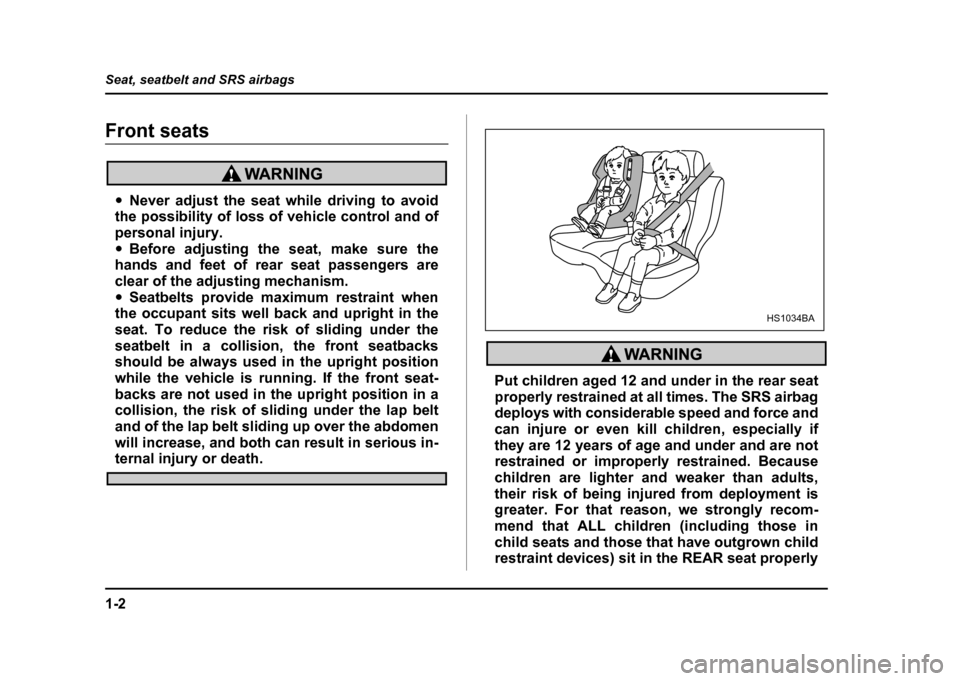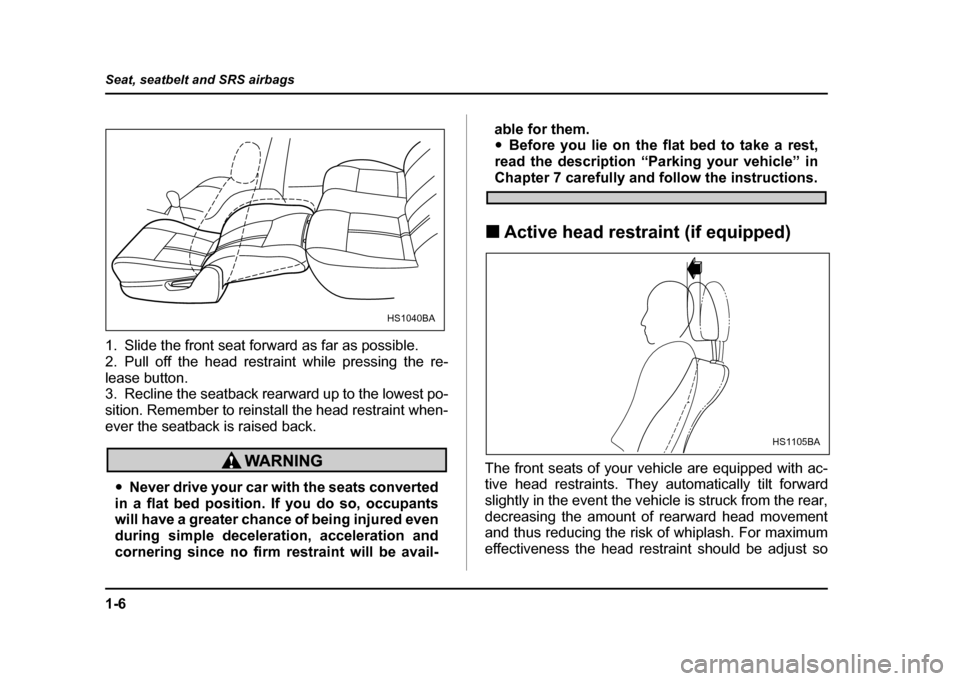Page 23 of 491
20
!
Combination meter
! WRX
1
86 7
23 5
4
UGF050BB
1) Fuel gauge (page 3-16)
2) Selector lever position indicator
(page 3-26)
3) Temperature gauge (page 3-17)
4) Tachometer (page 3-16)
5) Speedometer (page 3-15)
6) Odometer and trip meter (page 3-15)
7) Trip meter A/B selection and trip
meter reset knob (page 3-15)
8) Low fuel warning light (page 3-
17)
Page 24 of 491
21
–
CONTINUED –
!WRX-STi version
12 4 35 6
10 9 8 7
UGF051BB
1) Fuel gauge (page 3-9)
2) DCCD indicator (page 3-27)
3) Temperature gauge (page 3-10)
4) Tachometer (page 3-9)
5) REV indicator (page 3-12)
6) Speedometer (page 3-7)
7) Odometer and trip meter (page
3-8)
8) Trip meter A/B selection and trip
meter reset knob (page 3-8)
9) Ambient temperature indicator
(page 3-11)
10) Low fuel warning light (page 3- 10)
Page 25 of 491
22
!
Except turbo models
A
1
98 7 6 3
24 5
UGF052BB
1) Fuel gauge (page 3-16)
2) Selector lever position indicator
(page 3-26)
3) Temperature gauge (page 3-17)
4) Speedometer (page 3-15)
5) Tachometer (page 3-16)
6) Trip meter A/B selection and trip meter reset knob (page 3-15)
7) Odometer and trip meter (page
3-15)
8) Outside temperature indicator
(page 3-18)
9) Low fuel warning light (page 3- 17)
Page 26 of 491
23
–
CONTINUED –
!Warning and indicator light
Mark Name Page
Seatbelt warning light 3-19
SRS airbag system warning light 3-20
CHECK ENGINE warning light/
Malfunction indicator lamp 3-20
Charge warning light 3-21
Oil pressure warning light 3-21
AT OIL temperature warning light (if equipped) 3-22
or ABS warning light 3-23
or Brake system warning light 3-24
Door open warning light 3-25
Front-wheel drive warning light
(if equipped) 3-25
Turn signal indicator lights 3-26
High beam indicator light 3-26
Security system indicator light (if equipped) 2-14
Intercooler water spray warn-
ing light (if equipped) 3-25
Light indicator light (if equipped) 3-27
Cruise control indicator light (if equipped) 3-26
Cruise control set indicator light 3-26
REV indicator light (if equipped) 3-27
Rear differential oil tempera-
ture warning light (if equipped) 3-22
Electronic driver’s control cen-
ter differential auto indicator (if equipped) 3-26
Mark Name Page
Page 28 of 491

1-1
1
Seat, seatbelt and SRS airbags
Front seats .................................................... 1-2 Fore and aft adjustment ................................... 1-3
Reclining the seatback ..................................... 1-4
Seat cushion height adjustment (driver’s seat) 1-5
Head restraint adjustment (if equipped) ......... 1-5
Active head restraint (if equipped) .................. 1-6
Seat heater (if equipped) .............................. 1-7
Rear seats ..................................................... 1-8 Armrest (if equipped) ........................................ 1-9
Headrest adjustment – Wagon ........................ 1-11
Folding down the rear seat – Wagon .............. 1-12
Seatbelts ....................................................... 1-13 Seatbelt safety tips ........................................... 1-13
Emergency Locking Retractor (ELR) .............. 1-14
Automatic/Emergency Locking Retractor (A/ELR) ............................................................ 1-15
Seatbelt warning light and chime ............... 1-15
Fastening the seatbelt ...................................... 1-15
Seatbelt maintenance ....................................... 1-27
Front seatbelt pretensioners ....................... 1-27 System monitors ............................................... 1-29
System servicing .............................................. 1-29
Precautions against vehicle modification ...... 1-30
Child restraint systems ................................ 1-31 Where to place a child restraint system ......... 1-33
Choosing a child restraint system .................. 1-34
Installing child restraint systems with A/ELR seatbelt ............................................................ 1-35
Installing a booster seat ................................... 1-40
Installation of child restraint systems by use of lower and tether anchorages (LATCH) 1-42 Top tether anchorages ..................................... 1-46
SRS airbag (Supplemental Restraint System airbag) 1-52Vehicle with driver’s and front passenger’s SRS airbags and lap/shoulder restraints ..... 1-52
SRS frontal airbag ............................................ 1-56
SRS side airbag (if equipped) .......................... 1-64
SRS airbag system monitors ........................... 1-72
SRS airbag system servicing .......................... 1-73
Precautions against vehicle modification ...... 1-74
Page 29 of 491

1-2
Seat, seatbelt and SRS airbags
Seat, seatbelt and SRS airbagsFront seats
"
Never adjust the seat while driving to avoid
the possibility of loss of vehicle control and of
personal injury." Before adjusting the seat, make sure the
hands and feet of rear seat passengers are
clear of the adjusting mechanism." Seatbelts provide maximum restraint when
the occupant sits well back and upright in the
seat. To reduce the risk of sliding under the
seatbelt in a collision, the front seatbacks
should be always used in the upright position
while the vehicle is running. If the front seat-
backs are not used in the upright position in a
collision, the risk of sliding under the lap belt
and of the lap belt sliding up over the abdomen
will increase, and both can result in serious in-
ternal injury or death.
Put children aged 12 and under in the rear seat
properly restrained at all times. The SRS airbag
deploys with considerable speed and force and
can injure or even kill children, especially if
they are 12 years of age and under and are not
restrained or improperly restrained. Because
children are lighter and weaker than adults,
their risk of being injured from deployment is
greater. For that reason, we strongly recom-
mend that ALL children (including those in
child seats and those that have outgrown child
restraint devices) sit in the REAR seat properly
HS1034BA
Page 31 of 491
1-4
Seat, seatbelt and SRS airbags
!
Reclining the seatback
Pull the reclining lever up and adjust the seatback to
the desired position. Then release the lever and make
sure the seatback is securely locked into place.
The seatback placed in a reclined position can spring
back upward with force when released. When operat-
ing the reclining lever to return the seatback, hold it
lightly so that it may be raised back gradually.
To prevent the passenger from sliding under
the seatbelt in the event of a collision, always
put the seatback in the upright position while
the vehicle is in motion. Also, do not place ob-
jects such as cushions between the passenger
and the seatback. If you do so, the risk of slid-
ing under the lap belt and of the lap belt sliding
up over the abdomen will increase, and both
can result in serious internal injury or death.
UG1502BA
HS1037BA
Page 33 of 491

1-6
Seat, seatbelt and SRS airbags
1. Slide the front seat forward as far as possible.
2. Pull off the head restraint while pressing the re-
lease button.
3. Recline the seatback rearward up to the lowest po-
sition. Remember to reinstall the head restraint when-
ever the seatback is raised back.
"
Never drive your car with the seats converted
in a flat bed position. If you do so, occupants
will have a greater chance of being injured even
during simple deceleration, acceleration and
cornering since no firm restraint will be avail- able for them. "
Before you lie on the flat bed to take a rest,
read the description “Parking your vehicle” in
Chapter 7 carefully and follow the instructions.
! Active head restraint (if equipped)
The front seats of your vehicle are equipped with ac-
tive head restraints. They automatically tilt forward
slightly in the event the vehicle is struck from the rear,
decreasing the amount of rearward head movement
and thus reducing the risk of whiplash. For maximum
effectiveness the head restraint should be adjust so
HS1040BA
HS1105BA